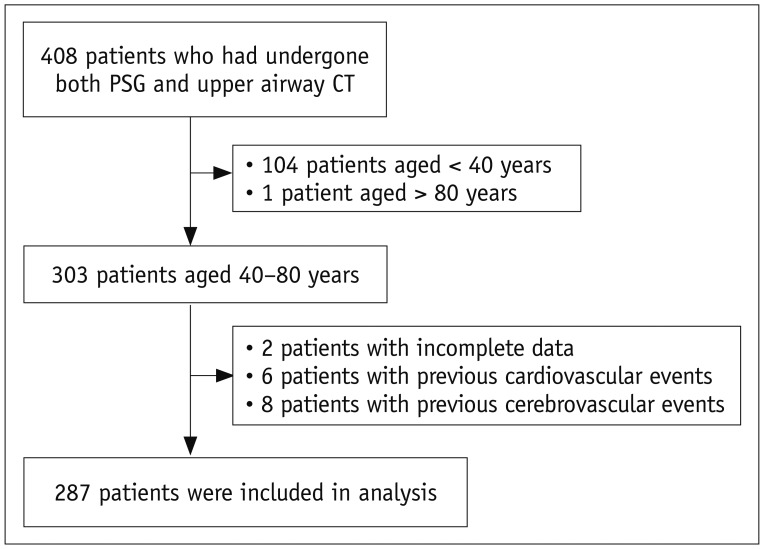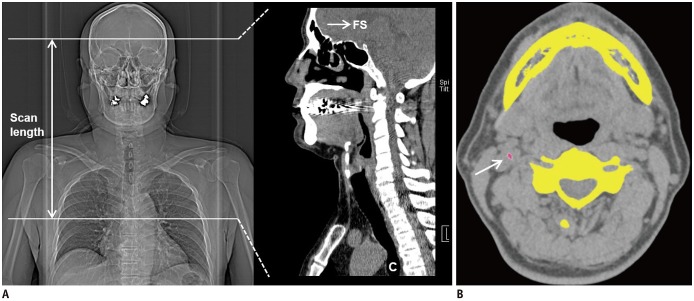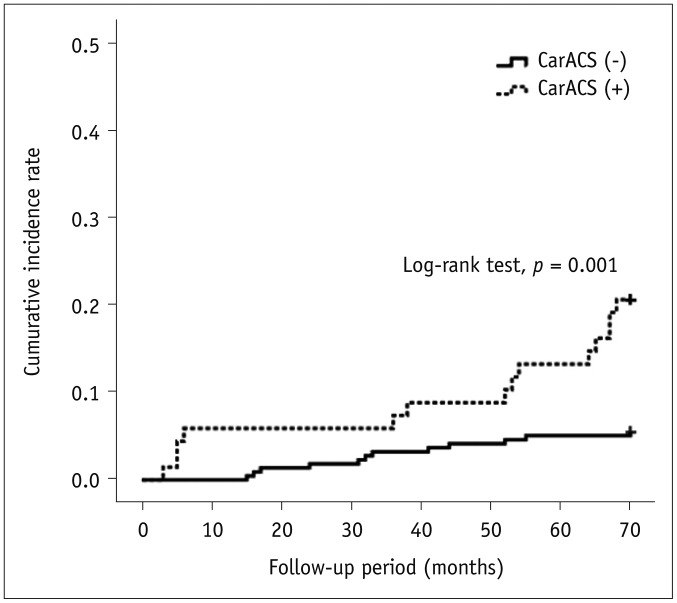Korean J Radiol.
2019 Apr;20(4):631-640. 10.3348/kjr.2018.0550.
Carotid Arterial Calcium Scoring Using Upper Airway Computed Tomography in Patients with Obstructive Sleep Apnea: Efficacy as a Clinical Predictor of Cerebrocardiovascular Disease
- Affiliations
-
- 1Department of Otorhinolaryngology-Head and Neck Surgery, Dong-A University College of Medicine, Busan, Korea. doncamel@dau.ac.kr
- 2Department of Radiology, Dong-A University College of Medicine, Busan, Korea.
- 3Department of Neurology, Dong-A University College of Medicine, Busan, Korea.
- 4Department of Neurosurgery, Dong-A University College of Medicine, Busan, Korea.
- 5Department of Oral and Maxillofacial Surgery, Dong-A University College of Medicine, Busan, Korea.
- 6Department of Otorhinolaryngology-Head and Neck Surgery, St. Mary's Medical Center, Busan, Korea.
- KMID: 2440486
- DOI: http://doi.org/10.3348/kjr.2018.0550
Abstract
OBJECTIVE
To evaluate the value of airway computed tomography (CT) in patients with obstructive sleep apnea (OSA) as a predictor of cerebrocardiovascular disease (CCVD) clinically, by quantitatively analyzing carotid arterial calcification (CarAC).
MATERIALS AND METHODS
This study included 287 patients aged 40-80 years, who had undergone both polysomnography (PSG) and airway CT between March 2011 and October 2015. The carotid arterial calcium score (CarACS) was quantified using the modified Agatston method on each upper airway CT. The OSA severity was categorized as normal, mild, moderate, and severe using the PSG results. Clinical characteristics, comorbid diseases, and lipid profiles of all patients were analyzed, and the prevalence of CCVDs was investigated during the follow up period (52.2 ± 16.0 months).
RESULTS
CCVD occurred in 27 patients (9.3%) at the end of follow-up, and the CCVD-present groups showed a significantly older mean age (57.5 years vs. 54.2 years), higher prevalence of hypertension (59% vs. 34%) and CarAC (51.9% vs. 20.8%), whereas sex, other comorbid diseases, and severity of OSA were not significantly different from the CCVD-absent group. A univariate analysis showed that age, hypertension, incidence of CarAC, and CarACS were risk factors for the occurrence of CCVD events. In a multivariate analysis, the incidence of CarAC was the only independent risk factor for CCVD.
CONCLUSION
CarAC is an independent risk factor for CCVD, whereas the severity of OSA is not a contributory risk factor in patients with OSA. Therefore, additional analysis of CarACS based on airway CT scans may be useful for predicting CCVD.
MeSH Terms
Figure
Reference
-
1. Gottlieb DJ, Yenokyan G, Newman AB, O'Connor GT, Punjabi NM, Quan SF, et al. Prospective study of obstructive sleep apnea and incident coronary heart disease and heart failure: the sleep heart health study. Circulation. 2010; 122:352–360. PMID: 20625114.2. Beaudin AE, Waltz X, Hanly PJ, Poulin MJ. Impact of obstructive sleep apnea and intermittent hypoxia on cardiovascular and cerebrovascular regulation. Exp Physiol. 2017; 102:743–763. PMID: 28439921.3. Maeder MT, Schoch OD, Rickli H. A clinical approach to obstructive sleep apnea as a risk factor for cardiovascular disease. Vasc Health Risk Manag. 2016; 12:85–103. PMID: 27051291.
Article4. Munoz R, Duran-Cantolla J, Martínez-Vila E, Gallego J, Rubio R, Aizpuru F, et al. Severe sleep apnea and risk of ischemic stroke in the elderly. Stroke. 2006; 37:2317–2321. PMID: 16888274.
Article5. Elkholy SH, Amer HA, Nada MM, Nada MA, Labib A. Sleep-related breathing disorders in cerebrovascular stroke and transient ischemic attacks: a comparative study. J Clin Neurophysiol. 2012; 29:194–198. PMID: 22469687.6. Tsuda H, Almeida FR, Tsuda T, Moritsuchi Y, Lowe AA. Cephalometric calcified carotid artery atheromas in patients with obstructive sleep apnea. Sleep Breath. 2010; 14:365–370. PMID: 20084549.
Article7. Tsuda H, Moritsuchi Y, Almeida FR, Lowe AA, Tsuda T. The relationship between cephalometric carotid artery calcification and Framingham risk score profile in patients with obstructive sleep apnea. Sleep Breath. 2013; 17:1003–1008. PMID: 23208741.
Article8. Agatston AS, Janowitz WR, Hildner FJ, Zusmer NR, Viamonte M Jr, Detrano R. Quantification of coronary artery calcium using ultrafast computed tomography. J Am Coll Cardiol. 1990; 15:827–832. PMID: 2407762.
Article9. Mahabadi AA, Möhlenkamp S, Lehmann N, Kälsch H, Dykun I, Pundt N, et al. Heinz Nixdorf recall study investigators. CAC score improves coronary and CV risk assessment above statin indication by ESC and AHA/ACC primary prevention guidelines. JACC Cardiovasc Imaging. 2017; 10:143–153. PMID: 27665163.10. Genders TS, Pugliese F, Mollet NR, Meijboom WB, Weustink AC, van Mieghem CA, et al. Incremental value of the CT coronary calcium score for the prediction of coronary artery disease. Eur Radiol. 2010; 20:2331–2340. PMID: 20559838.
Article11. Elias-Smale SE, Proença RV, Koller MT, Kavousi M, van Rooij FJ, Hunink MG, et al. Coronary calcium score improves classification of coronary heart disease risk in the elderly: the Rotterdam study. J Am Coll Cardiol. 2010; 56:1407–1414. PMID: 20946998.12. Denzel C, Lell M, Maak M, Höckl M, Balzer K, Müller KM, et al. Carotid artery calcium: accuracy of a calcium score by computed tomography-an in vitro study with comparison to sonography and histology. Eur J Vasc Endovasc Surg. 2004; 28:214–220. PMID: 15234704.
Article13. Miralles M, Merino J, Busto M, Perich X, Barranco C, Vidal-Barraquer F. Quantification and characterization of carotid calcium with multi-detector CT-angiography. Eur J Vasc Endovasc Surg. 2006; 32:561–567. PMID: 16979917.
Article14. Katano H, Yamada K. Analysis of calcium in carotid plaques with Agatston scores for appropriate selection of surgical intervention. Stroke. 2007; 38:3040–3044. PMID: 17901382.
Article15. Kaur S, Rai S, Kaur M. Comparison of reliability of lateral cephalogram and computed tomography for assessment of airway space. Niger J Clin Pract. 2014; 17:729–736. PMID: 25385910.
Article16. Somers VK, White DP, Amin R, Abraham WT, Costa F, Culebras A, et al. Sleep apnea and cardiovascular disease: an American Heart Association/American College of Cardiology Foundation scientific statement from the American Heart Association council for high blood pressure research professional education committee, council on clinical cardiology, stroke council, and council on cardiovascular nursing. J Am Coll Cardiol. 2008; 52:686–717. PMID: 18702977.17. Yaffe K, Laffan AM, Harrison SL, Redline S, Spira AP, Ensrud KE, et al. Sleep-disordered breathing, hypoxia, and risk of mild cognitive impairment and dementia in older women. JAMA. 2011; 306:613–619. PMID: 21828324.
Article18. Silva GE, An MW, Goodwin JL, Shahar E, Redline S, Resnick H, et al. Longitudinal evaluation of sleep-disordered breathing and sleep symptoms with change in quality of life: the Sleep Heart Health Study (SHHS). Sleep. 2009; 32:1049–1057. PMID: 19725256.
Article19. Peppard PE, Szklo-Coxe M, Hla KM, Young T. Longitudinal association of sleep-related breathing disorder and depression. Arch Intern Med. 2006; 166:1709–1715. PMID: 16983048.
Article20. Peppard PE, Young T, Barnet JH, Palta M, Hagen EW, Hla KM. Increased prevalence of sleep-disordered breathing in adults. Am J Epidemiol. 2013; 177:1006–1014. PMID: 23589584.
Article21. Wang X, Zhang Y, Dong Z, Fan J, Nie S, Wei Y. Effect of continuous positive airway pressure on long-term cardiovascular outcomes in patients with coronary artery disease and obstructive sleep apnea: a systematic review and meta-analysis. Respir Res. 2018; 19:61. PMID: 29636058.
Article22. Anandam A, Patil M, Akinnusi M, Jaoude P, El-Solh AA. Cardiovascular mortality in obstructive sleep apnoea treated with continuous positive airway pressure or oral appliance: an observational study. Respirology. 2013; 18:1184–1190. PMID: 23731062.
Article23. Peker Y, Strollo PJ Jr. CPAP did not reduce cardiovascular events in patients with coronary or cerebrovascular disease and moderate to severe obstructive sleep apnoea. Evid Based Med. 2017; 22:67–68. PMID: 28069600.
Article24. Chousangsuntorn K, Bhongmakapat T, Apirakkittikul N, Sungkarat W, Supakul N, Laothamatas J. Computed tomography characterization and comparison with polysomnography for obstructive sleep apnea evaluation. J Oral Maxillofac Surg. 2018; 76:854–872. PMID: 28988101.
Article25. Rodrigues MM, Pereira Filho VA, Gabrielli MFR, Oliveira TFM, Batatinha JAP, Passeri LA. Volumetric evaluation of pharyngeal segments in obstructive sleep apnea patients. Braz J Otorhinolaryngol. 2018; 84:89–94.
Article26. Fleck RJ, Ishman SL, Shott SR, Gutmark EJ, McConnell KB, Mahmoud M, et al. Dynamic volume computed tomography imaging of the upper airway in obstructive sleep apnea. J Clin Sleep Med. 2017; 13:189–196. PMID: 27784422.
Article27. Lin YS, Liu PH, Chu PH. Obstructive sleep apnea independently increases the incidence of heart failure and major adverse cardiac events: a retrospective population-based follow-up study. Acta Cardiol Sin. 2017; 33:656–663. PMID: 29167620.28. Lui MM, Sau-Man M. OSA and atherosclerosis. J Thorac Dis. 2012; 4:164–172. PMID: 22833822.29. Curry BD, Bain JL, Yan JG, Zhang LL, Yamaguchi M, Matloub HS, et al. Vibration injury damages arterial endothelial cells. Muscle Nerve. 2002; 25:527–534. PMID: 11932970.
Article30. Kohler M, Stradling JR. Mechanisms of vascular damage in obstructive sleep apnea. Nat Rev Cardiol. 2010; 7:677–685. PMID: 21079639.
Article31. Lewis DA, Brooks SL. Cartoid artery calcification in a general dental population: a retrospective study of panoramic radiographs. Gen Dent. 1999; 47:98–103. PMID: 10321159.32. Kumagai M, Yamagishi T, Fukui N, Chiba M. Carotid artery calcification seen on panoramic dental radiographs in the asian population in Japan. Dentomaxillofac Radiol. 2007; 36:92–96. PMID: 17403886.
Article33. Brand HS, Mekenkamp WC, Baart JA. Prevalence of carotid artery calcification on panoramic radiographs. Ned Tijdschr Tandheelkd. 2009; 116:69–73. PMID: 19280889.34. Cohen SN, Friedlander AH, Jolly DA, Date L. Carotid calcification on panoramic radiographs: an important marker for vascular risk. Oral Surg Oral Med Oral Pathol Oral Radiol Endod. 2002; 94:510–514. PMID: 12374929.
Article35. Friedlander AH, Manesh F, Wasterlain CG. Prevalence of detectable carotid artery calcifications on panoramic radiographs of recent stroke victims. Oral Surg Oral Med Oral Pathol. 1994; 77:669–673. PMID: 8065736.
Article36. Odink AE, van der Lugt A, Hofman A, Hunink MG, Breteler MM, Krestin GP, et al. Association between calcification in the coronary arteries, aortic arch and carotid arteries: the Rotterdam study. Atherosclerosis. 2007; 193:408–413. PMID: 16919637.
Article37. Wong ND, Gransar H, Shaw L, Polk D, Moon JH, Miranda-Peats R, et al. Thoracic aortic calcium versus coronary artery calcium for the prediction of coronary heart disease and cardiovascular disease events. JACC Cardiovasc Imaging. 2009; 2:319–326. PMID: 19356578.
Article38. Gibson AO, Blaha MJ, Arnan MK, Sacco RL, Szklo M, Herrington DM, et al. Coronary artery calcium and incident cerebrovascular events in an asymptomatic cohort. The MESA Study. JACC Cardiovasc Imaging. 2014; 7:1108–1115. PMID: 25459592.39. Hermann DM, Gronewold J, Lehmann N, Moebus S, Jöckel KH, Bauer M, et al. Coronary artery calcification is an independent stroke predictor in the general population. Stroke. 2013; 44:1008–1013. PMID: 23449263.
Article40. Chaikriangkrai K, Jhun HY, Palamaner Subash Shantha G, Bin Abdulhak A, Sigurdsson G, Nabi F, et al. Coronary artery calcium score as a predictor for incident stroke: systematic review and meta-analysis. Int J Cardiol. 2017; 236:473–477. PMID: 28202259.
Article41. Peker Y, Hedner J, Norum J, Kraiczi H, Carlson J. Increased incidence of cardiovascular disease in middle-aged men with obstructive sleep apnea: a 7-year follow-up. Am J Respir Crit Care Med. 2002; 166:159–165. PMID: 12119227.42. Lavie P, Lavie L, Herer P. All-cause mortality in males with sleep apnoea syndrome: declining mortality rates with age. Eur Respir J. 2005; 25:514–520. PMID: 15738297.
Article43. Thomas IC, Forbang NI, Criqui MH. The evolving view of coronary artery calcium and cardiovascular disease risk. Clin Cardiol. 2018; 41:144–150. PMID: 29356018.
Article44. Young T, Finn L, Peppard PE, Szklo-Coxe M, Austin D, Nieto FJ, et al. Sleep disordered breathing and mortality: eighteen-year follow-up of the Wisconsin sleep cohort. Sleep. 2008; 31:1071–1078. PMID: 18714778.45. Punjabi NM, Caffo BS, Goodwin JL, Gottlieb DJ, Newman AB, O'Connor GT, et al. Sleep-disordered breathing and mortality: a prospective cohort study. PLoS Med. 2009; 6:e1000132. PMID: 19688045.
Article
- Full Text Links
- Actions
-
Cited
- CITED
-
- Close
- Share
- Similar articles
-
- The Role of Endothelin-1 in Obstructive Sleep Apnea Syndrome and Pulmonary Hypertension
- Upper airway studies in patients with obstructive sleep apnea syndrome
- Two Cases of Pediatric Obstructive Hypoventilation Managed with Upper Airway Surgery
- Pathogenesis of Obstructive Sleep Apnea
- Upper airway myofunctional exercise: a systematic review




